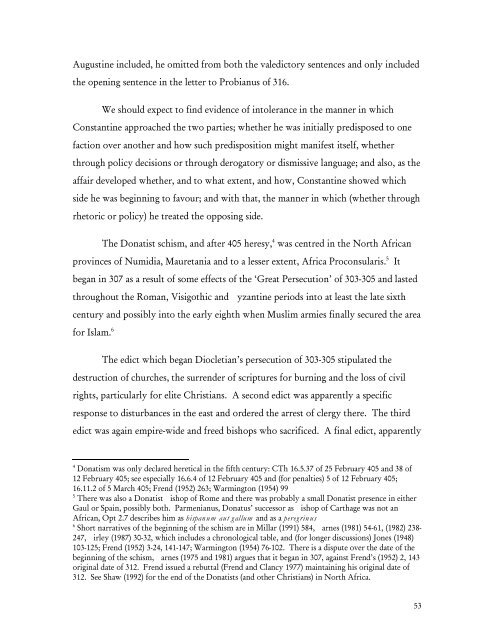Religious Intolerance in the Later Roman Empire - Bad request ...
Religious Intolerance in the Later Roman Empire - Bad request ...
Religious Intolerance in the Later Roman Empire - Bad request ...
Create successful ePaper yourself
Turn your PDF publications into a flip-book with our unique Google optimized e-Paper software.
August<strong>in</strong>e <strong>in</strong>cluded, he omitted from both <strong>the</strong> valedictory sentences and only <strong>in</strong>cluded<br />
<strong>the</strong> open<strong>in</strong>g sentence <strong>in</strong> <strong>the</strong> letter to Probianus of 316.<br />
We should expect to f<strong>in</strong>d evidence of <strong>in</strong>tolerance <strong>in</strong> <strong>the</strong> manner <strong>in</strong> which<br />
Constant<strong>in</strong>e approached <strong>the</strong> two parties; whe<strong>the</strong>r he was <strong>in</strong>itially predisposed to one<br />
faction over ano<strong>the</strong>r and how such predisposition might manifest itself, whe<strong>the</strong>r<br />
through policy decisions or through derogatory or dismissive language; and also, as <strong>the</strong><br />
affair developed whe<strong>the</strong>r, and to what extent, and how, Constant<strong>in</strong>e showed which<br />
side he was beg<strong>in</strong>n<strong>in</strong>g to favour; and with that, <strong>the</strong> manner <strong>in</strong> which (whe<strong>the</strong>r through<br />
rhetoric or policy) he treated <strong>the</strong> oppos<strong>in</strong>g side.<br />
The Donatist schism, and after 405 heresy, 4 was centred <strong>in</strong> <strong>the</strong> North African<br />
prov<strong>in</strong>ces of Numidia, Mauretania and to a lesser extent, Africa Proconsularis. 5 It<br />
began <strong>in</strong> 307 as a result of some effects of <strong>the</strong> ‘Great Persecution’ of 303-305 and lasted<br />
throughout <strong>the</strong> <strong>Roman</strong>, Visigothic and Byzant<strong>in</strong>e periods <strong>in</strong>to at least <strong>the</strong> late sixth<br />
century and possibly <strong>in</strong>to <strong>the</strong> early eighth when Muslim armies f<strong>in</strong>ally secured <strong>the</strong> area<br />
for Islam. 6<br />
The edict which began Diocletian’s persecution of 303-305 stipulated <strong>the</strong><br />
destruction of churches, <strong>the</strong> surrender of scriptures for burn<strong>in</strong>g and <strong>the</strong> loss of civil<br />
rights, particularly for elite Christians. A second edict was apparently a specific<br />
response to disturbances <strong>in</strong> <strong>the</strong> east and ordered <strong>the</strong> arrest of clergy <strong>the</strong>re. The third<br />
edict was aga<strong>in</strong> empire-wide and freed bishops who sacrificed. A f<strong>in</strong>al edict, apparently<br />
4 Donatism was only declared heretical <strong>in</strong> <strong>the</strong> fifth century: CTh 16.5.37 of 25 February 405 and 38 of<br />
12 February 405; see especially 16.6.4 of 12 February 405 and (for penalties) 5 of 12 February 405;<br />
16.11.2 of 5 March 405; Frend (1952) 263; Warm<strong>in</strong>gton (1954) 99<br />
5 There was also a Donatist Bishop of Rome and <strong>the</strong>re was probably a small Donatist presence <strong>in</strong> ei<strong>the</strong>r<br />
Gaul or Spa<strong>in</strong>, possibly both. Parmenianus, Donatus’ successor as Bishop of Carthage was not an<br />
African, Opt 2.7 describes him as hispanum aut gallum and as a peregr<strong>in</strong>us<br />
6 Short narratives of <strong>the</strong> beg<strong>in</strong>n<strong>in</strong>g of <strong>the</strong> schism are <strong>in</strong> Millar (1991) 584, Barnes (1981) 54-61, (1982) 238-<br />
247, Birley (1987) 30-32, which <strong>in</strong>cludes a chronological table, and (for longer discussions) Jones (1948)<br />
103-125; Frend (1952) 3-24, 141-147; Warm<strong>in</strong>gton (1954) 76-102. There is a dispute over <strong>the</strong> date of <strong>the</strong><br />
beg<strong>in</strong>n<strong>in</strong>g of <strong>the</strong> schism, Barnes (1975 and 1981) argues that it began <strong>in</strong> 307, aga<strong>in</strong>st Frend’s (1952) 2, 143<br />
orig<strong>in</strong>al date of 312. Frend issued a rebuttal (Frend and Clancy 1977) ma<strong>in</strong>ta<strong>in</strong><strong>in</strong>g his orig<strong>in</strong>al date of<br />
312. See Shaw (1992) for <strong>the</strong> end of <strong>the</strong> Donatists (and o<strong>the</strong>r Christians) <strong>in</strong> North Africa.<br />
53

















